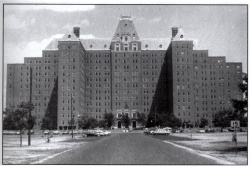Edgewood State Hospital
| Edgewood State Hospital | |
|---|---|
 | |
| Construction Began | 1940 |
| Current Status | Demolished |
| Building Style | Cottage Plan |
| Location | Deer Park, NY |
| Alternate Names | Mason General Hospital |
History[edit]
Edgewood State Hospital was a tubercular/psychiatric hospital complex that formerly stood in Deer Park, New York, on Long Island, New York, USA. It was one of four state mental asylums built on Long Island (the others being Kings Park, Central Islip, and Pilgrim), and was the last one of the four to be built.
The hospital was built in the early 1940s, believed to be a Works Progress Administration-funded project. It consisted only of ten buildings (including its massive, prominent 13-story main building), making it the smallest of the four as well (although it was planned to be a larger complex, those plans never made it past paper). The facility was commandeered by the War Department after the United States entered World War II. The War Department completed its construction for use as a psychiatric facility for battle-traumatized soldiers. Its entire campus (in addition to three buildings from nearby Pilgrim State Hospital and numerous temporary structures) was used as "Mason General Hospital" by the department.
When the war ended, the hospital was transferred back to New York State, where it essentially operated as the tubercular division of Pilgrim for a few years. In 1946 film director John Huston was assigned by the U.S government to film a documentary film about recovering soldiers in the hospital for propaganda purposes, the film was called "Let There Be Light".
Advancements in medicine throughout the 1950s and 1960s that offered alternatives to institutionalization led to decentralization, and the hospital closed in 1971. In the 80’s, there were huge fires that seemed to burn on an annual basis. These fires took their toll on the Hospital, destroying the trademark French style château roof, exposing the metal support pillars. The buildings became home to vagrants, vandals, and partying teenagers, while the land became a dumping ground for old tires, stolen cars, mattresses and other garbage. In May of 1988, City Construction Development Inc. of Jersey City bid $4.9 million to demolish the former Deer Park hospital's four main buildings. On August 16, 1989, to the delight of local citizens and politicians, the tallest building in Long Island, was crumbled to dust. For a few seconds, it looked like the northwest wing of the main building was not going to collapse. However, it finally succumbed to it’s fate, about 5 seconds after the rest of the building. On this day, the main building (102), the nurses dormitory (140), the remnants of the gym, church, movie theater, and kitchen (building 105) were demolished. The final bill for demolition on this day was estimated to be between 11 and $13 million, and it was the largest demolition of state-owned property ever. The final remaining structures were disposed of around 1990–91. Today, the site sits as an open, state-protected oak-brush plains preserve, but one can still find remnants of the former hospital, such as the old rail spur, fire hydrants, etc., scattered about.[1][2]
Books[edit]
- The farm colonies: Caring for New York City's mentally ill in Long Island's state hospitals, by Leo Polaski
Images[edit]
Video[edit]
Let There Be Light was a 1946 American documentary film directed by John Huston.
The film was the final entry in a John Huston trilogy of films produced by the request of the U.S. This documentary film follows 75 U.S. soldiers who have sustained debilitating emotional trauma and depression. A series of scenes chronicle their entry into a psychiatric hospital, their treatment and eventual recovery.
Much of the filming was shot at Edgewood State Hospital.
The film was controversial in its extremely effective portrayal of shell-shocked soldiers from the war. It was subsequently banned after its release despite the fact that the movie was commissioned by the US Army itself, due to the potentially demoralizing effects the film might have on the soldiers.



